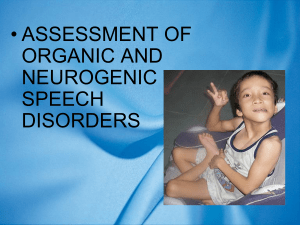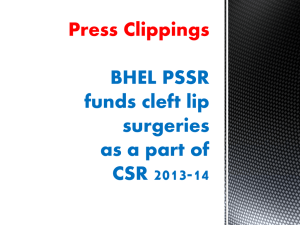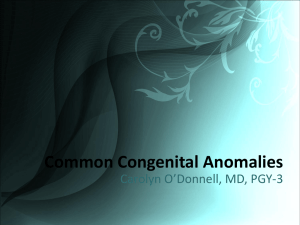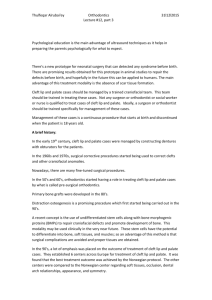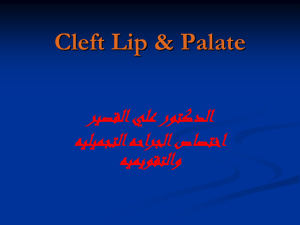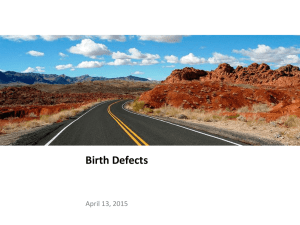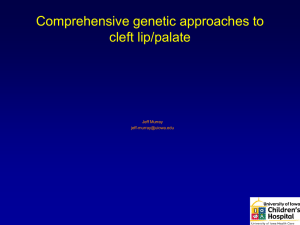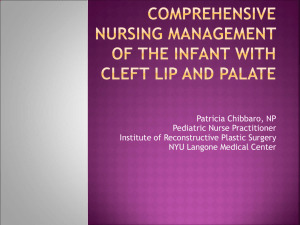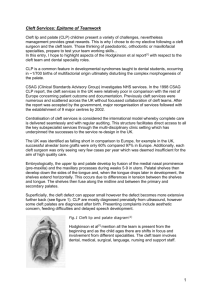PowerPoint_Format
advertisement
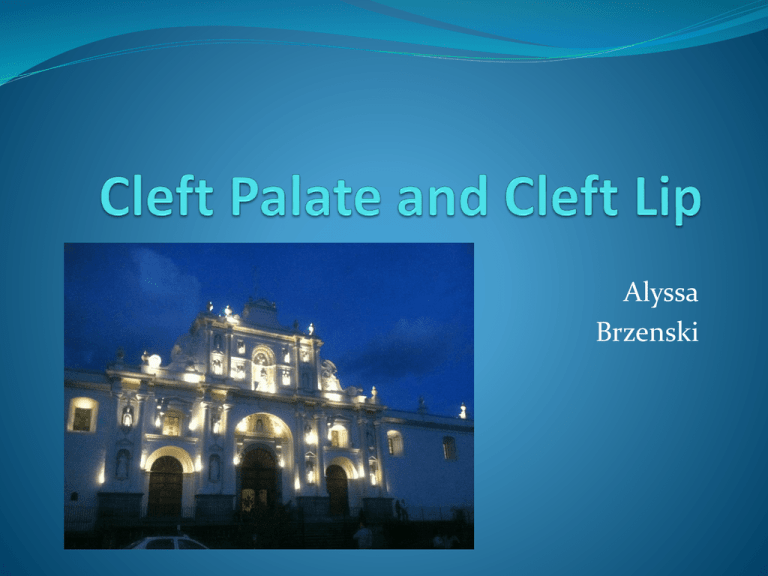
Alyssa Brzenski Overview Basic statistics of Cleft Lips and Cleft Palate Basic embryology of Cleft Lips and Palates Common Associated Syndromes Anesthetic Implications Common complications Cleft Lip/Palate Statistics Merrit L. Understanding the Embryology and Genetics of Cleft Lip and Palate. Advances in Neonatal Care 2005; 5: 64-71. Risk Factors Merrit L. Understanding the Embryology and Genetics of Cleft Lip and Palate. Advances in Neonatal Care 2005; 5: 64-71. Embryology Merrit L. Understanding the Embryology and Genetics of Cleft Lip and Palate. Advances in Neonatal Care 2005; 5: 64-71. Facial Development Cleft Lip Embryology Cleft Palate Non-syndromic Orofascial Clefts Mossey et al. Cleft Lip and Palate. Lancet 2009; 374: 1773-85. Pierre Robin Retrognathia Glossoptosis Treacher Collins Mandibular hypoplasia Triangular facies Cleft palate Microtia Cardiac anomalies Renal anomalies Choanal atresia Goldenhar Syndrome Orbital Distortion Mandibular Hypoplasia Ear Anomaly Nerve involvement (auricular, ophthalmologic, facial nerve) Soft Tissue deficiency Should I expect a difficult intubation? 7% of children for Cleft lip or Cleft palate Retrognathia Age less than 6 months Bilateral cleft Wide Cleft No difficulty ventilating Anesthesia Mask Induction PIVx1 Intubate and place an oral rae Balanced anesthetic Post-op Pain control with long-acting narcotic Infraorbital Nerve blocks for cle Awake on extubation to protect airway May have tounge stich Avoid oral airways Infraorbital Nerve Block Pediatric Peripheral Nerve Blocks. NYSORA. Causes of Upper Airway obstruction Edema of the tongue from the Dingman retractor Reduction in the size of the oropharynx Excessive sedation Post-operative Palate Fistula Causes Type of cleft Wound tension Type of repair Single layer repair Infection Age of patient at time of repair Future Procedures Ear Tubes Palatoplasty- for velopharyngeal insufficiency Alveolar Bone Graft (8-10 years of age) Extensive orthodontic care Speech Therapy Questions? Sources Merrit L. Understanding the Embryology and Genetics of Cleft Lip and Palate. Advances in Neonatal Care 2005; 5: 64-71. Arteau-Gauthier I, Leclerc JE, Godbout A. Can we predict a difficult intubation in cleft lip/palate patients? J Otolaryngol Head Neck Surg. 2011; 40:413-9. Mossey PA, Little J, Munger RG, Dixon MJ, Shaw WC. Cleft lip and Palate. The Lancet. 2009; 374: 1773-85. Loose JE, et al. A Successful Algorithm for Limiting Postoperative Fistulae following Palatal Procedures in the Patient with Orofacial Clefting. Plastic and Reconstructive Surgery. 2008; 122: 544-54. Shan Phua Y, Chalain T.Incidence of Oronasal Fistulae and Velopharyngeal Insufficiency After Cleft Palate Repair: An Audit of 211 Children Born Between 1990 and 2004. Cleft Palate-Craniofacial Journal. 2008; 45: 172-8. Cote, Lerman, Todres. A Practice of Anesthesia for Infants and Children. 2009. 4th Ed. Tremlett M. Anaesthesia for Cleft Lip and Palate Surgery. Current Anaesthesia and Critical Care. 2004; 15: 309-16.


